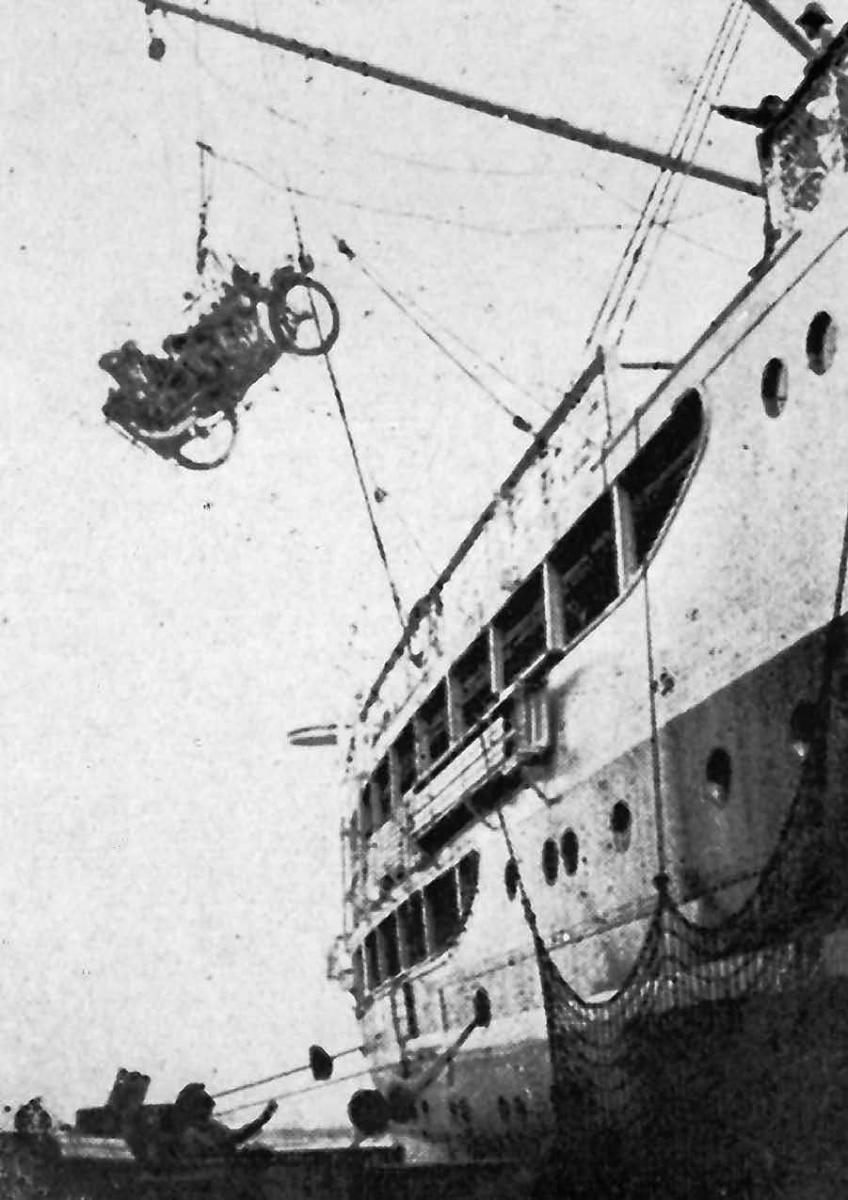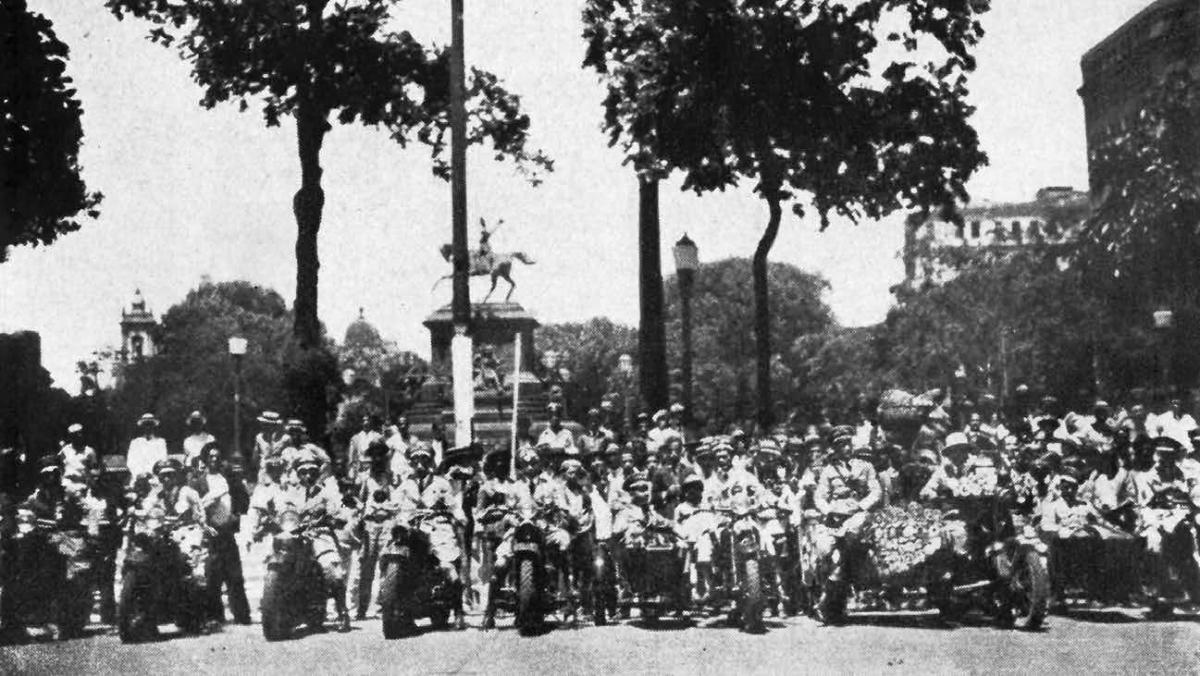Moroccan Trails

In Around the World on a Motorcycle, Zoltán Sulkowsky documents a daring voyage made by two Hungarian globe-trotters starting in 1928, one of the first successful and surprisingly little-known circumnavigation attempts on motorbike. Zoltán Sulkowsky and his friend Gyula Bartha, two motorized Magellans, spent years discovering for themselves, and for future readers, our world during the deceptive lull between the two World Wars. To celebrate their accomplishments we are sharing excerpts of their story with our readers over the next few weeks.
Our small boat, Miguel Primo de Rivera (although someone must have painted over the white letters of its name since we last sailed in it) floated serenely into the harbor at Ceuta. A whole new world opened before our wondering eyes. Although only a narrow strait separated it from familiar Europe, we were overwhelmed by the novelty of Africa. Even while we sailed on the boat, the feeling that we were entering a new world never left us.

The crowns of tall date palms waved gently to and fro in the wind, as if in greeting. In the harbor, the brown of storehouses and piers set off numerous moving white dots, which were Arabs, clad in flowing, white garments. Their robes flapped noticeably at every move, and movement there was in abundance, because our ship was just landing. As soon as our feet touched dry land, we were inundated by hundreds of eager Arabians, as were our fellow passengers. Arabian porters, tour guides, hotel receptionists, shoe shiners, money changers, and a vast assortment of people belonging to other professions surrounded us, until we could hardly move.
Our bike was unloaded shortly after we had landed, and then we were ready to tackle the highways and byways of this new continent. Things weren’t as simple as we had hoped. We had travel documents granting us free movement throughout the territory of tiny Spanish Morocco, but our passage into the French regions was not assured.
Although the World War had been over for ten whole years, the French were still hesitant when granting travel rights to their former enemies. We were forced to send a telegram to the governor stationed in Rabat. Our difficulties were soon solved when we received papers granting us access to all French colonies and protectorates in Africa. With our new documents in hand, we headed east. Our hope was to travel around the world of course, by keeping due east, but we were forced to travel north on south on various occasions, and we anticipated that a time would come when we might have to “regress” towards the west.
Although anxious to progress, we were in no hurry to miss the beautiful sights along the way.We visited nearly all the regions of Morocco and passed through every city or town worthy of mention. After Ceuta came Tetuan, then we headed south to Casablanca via Tangier and Rabat. Following this portion of our journey, we found ourselves near the desert—real Africa—upon visiting Marrakech at the foot of the great Atlas Mountains. From Marrakech, we were forced to turn back for a stretch, and it wasn’t until we arrived in Meknes that we were able to head due east again, passing through Fez, Taza, Algiers, and Tunis. It was in Tangier that we readied our bike for the long, arduous journey. Belongings we no longer felt were necessary we mailed home. We carefully weighed the importance of each item and kept only what was indispensable.
On the other hand, we were also forced to buy a few items we felt we would need in the coming weeks and months: lengths of strong rope suitable for towing, an enlarged gas tank and water, in large amounts. The best way to transport water was in water sacks, which boasted a natural and infinitely simple self-cooling mechanism. As the water seeped out in tiny quantities, the sides of the sack remained wet, and so, however hot the air around us, the constant evaporation kept our water supply at a very acceptable temperature. It was really as we traveled Africa that we realized what a blessing the sidecar was proving to be. There was much more space for our supplies, and the bike remained balanced even as we rode across unsteady sand. Then again, the sand roads caused us little trouble at first. We left the worst roads behind us as we crossed the border from Spanish into French Morocco. French roads were first class, almost without exception. Most of the main roads were covered in asphalt or stone that had been beautifully flattened by a steamroller, and we often reached our Harley’s speed limit while riding them.
A hundred kilometers before reaching the French-Moroccan border, we remembered that we needed to be careful, because Morocco was far from peaceful. The Riff-Kabil uprising was in full swing, and both the Spanish and the French were thoroughly engaged in countering local guerilla attacks. Both the French and the Spanish were reluctant to risk the lives of their own, yet the nearby hills were the sites of daily bloody battles. We came within 60 km of Ouezzan, which was then the site of another fierce encounter between the Riffs and the French. The roads were filled with army vehicles; buses carrying civilians were heavily guarded by soldiers armed to the teeth. In the vicinity of Marrakech, we no longer knew what exactly to expect. Roads leading into the Sahara were deserted, the local Arab population unpredictable. We were given the friendly suggestion to cover our tropical hats with white headscarves. As the rest of our clothing was white, we hoped to pass as fellow countrymen to Arabs on horseback, who might be viewing us from a distance...

Get your own copy of Around the World on a Motorcycle today!

